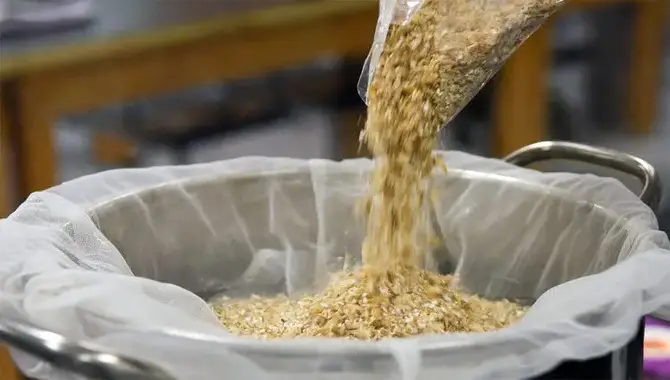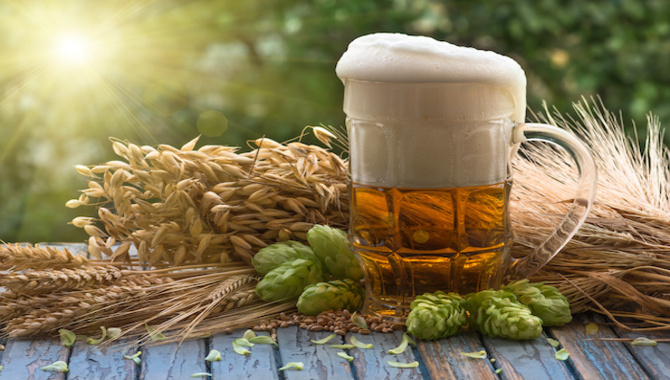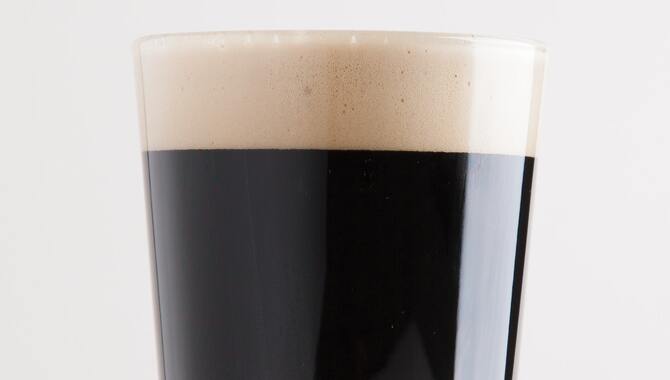Brewing your own Irish stout at home can be a rewarding and delicious experience. Whether you’re a seasoned homebrewer or just starting out, this guide will provide you with all the information you need to create your own batch of rich and flavorful Irish stout.
From selecting the right ingredients to mastering the brewing process, we’ll walk you through each step so that you can enjoy a pint of homemade stout that rivals those found in your favorite pubs. So grab your brewing equipment and get ready to embark on a journey of flavor and craftsmanship.
We will walk you through the entire process of brewing Irish Stout in just 5 easy steps. We’ll also discuss the effects of drinking Irish Stout and share some tips for perfecting your brew. So grab your brewing equipment and get ready to impress your friends with your batch of delicious Irish Stout. we’ll answer that too. Let’s dive in and make some craft beer magic happen!

How To Brew Irish Stout At Home: 5 Easy Steps

Brewing Irish stout at home can be a rewarding and delicious experience for beer enthusiasts. Irish stout is known for its dark color, rich flavors, and creamy mouthfeel. To brew your own batch of Irish stout at home, you will need some basic brewing equipment such as a fermenter, airlock, and siphon.
However, Brewing Irish Stout at home can be a fun and rewarding experience for beer lovers. With just a few simple steps, you can create your own delicious stout right in your own kitchen. Here are 5 easy steps to brew Irish Stout at home: With these 5 easy steps, you’ll soon be sipping on a delicious pint of homemade Irish Stout that rivals even the best commercial brews. Cheers
Step 1: Gather The Necessary Ingredients
To brew Irish stout at home, gather malt extract, specialty grains, hops, yeast, and water. Malt extract serves as the beer’s base and imparts a characteristic sweet flavor. Specialty grains, such as roasted barley and flaked barley, contribute depth and complexity to the stout’s flavor profile, while hops add bitterness and aroma to balance the sweetness of the malt.
Choose your hops wisely, considering options like East Kent Goldings or Challenger. Yeast plays a crucial role in fermentation, converting malt sugars into alcohol and carbon dioxide. Opt for an Irish ale yeast or a strain that imparts clean and crisp flavors. To maintain the brew’s quality, use clean, filtered water, avoiding tap water with chlorine or impurities.
Step 2: Prepare The Grain Bill

To prepare the grain bill for your homemade Irish stout, start by selecting and weighing the necessary grains for your recipe. The typical grain bill for Irish stout includes pale malt, roasted barley, and specialty grains like chocolate or black patent malt.
Carefully measure out the appropriate amounts of each grain according to your recipe. Then, crush the grains using a grain mill or request assistance from your local homebrew shop. Once the grains are crushed, place them in a mesh bag or muslin cloth, and securely tie it closed.
Add the grain bag to a large pot of water and heat it to a temperature of approximately 150-160°F (65-71°C). Maintain this temperature for approximately one hour to extract the desired flavors from the grains.
Step 3: Boil The Wort
Boiling the wort is a crucial step in the brewing process of How to Brew Irish Stout at Home. This step helps extract flavors from the malt and hops, sterilizes the liquid, and concentrates the sugars. The length of the boiling process can vary from 60 to 90 minutes depending on the recipe.
Throughout the boiling process, hops are added at specific intervals to achieve the desired bitterness and aroma in the Irish Stout. This boiling action allows the flavors from the hops and malt to meld together, resulting in the distinct taste of the homemade brew.
While boiling the wort, it’s important to keep a close eye on the pot to avoid boiling over. Adjusting the heat or using a larger pot can help maintain control during the boiling process.
Step 4: Ferment The Beer

To brew your own Irish Stout at home, one crucial step is fermenting the beer. After boiling and cooling your wort, it’s time to transfer it to a fermentation vessel. Ensuring proper sanitation of the vessel, airlock, and equipment is essential for preventing contamination.
Once sanitized, transfer the cooled wort to the fermentation vessel, leaving room for yeast activity. Choose a suitable yeast strain for stouts, such as Irish ale yeast, and add it to the wort according to package instructions.
Seal the vessel with an airlock to allow carbon dioxide to escape while keeping out oxygen and contaminants. Place the vessel in a cool, dark area with a consistent temperature range of around 65-70°F for optimal fermentation.
Step 5: Enjoy Your Homemade Irish Stout.
After all your hard work and patience, it’s time to reap the rewards and relish in the satisfaction of enjoying your very own homemade Irish stout! Pour yourself a pint and savor the rich flavors and aromas of this classic beer style. You deserve it!
The roasted barley, malt, and hops come together to create a deep and complex flavor profile, with notes of chocolate, coffee, and caramel. The smooth and creamy mouthfeel adds to the overall enjoyment, making each sip a truly satisfying experience.
As you raise your glass, take a moment to appreciate the dark brown to black color, often accompanied by a creamy tan head. Inhale the inviting aroma of roasted malt and subtle hop notes.
Relishing in your homemade Irish stout is not just about the taste, but also the pride and accomplishment of successfully brewing your own beer. Share your creation with friends and family, or savor it in solitude as you celebrate your brewing skills. Cheers to a job well done!
Effects Of Drinking Irish Stout

Irish Stout, with its rich and creamy texture, has long been a favorite among beer enthusiasts. Brewed with roasted barley, this beer offers a unique and complex taste profile. Its moderate hop bitterness and low carbonation levels contribute to a smooth and flavorful drinking experience.
Irish Stout can be enjoyed in moderation, offering potential health benefits such as improving heart health and reducing the risk of certain diseases. However, it is important to drink responsibly and be mindful of your alcohol intake.
Whether you’re enjoying a pint at the pub or brewing your own batch at home, Irish Stout is a delicious choice. Its distinctive flavors and potential health benefits make it a versatile and popular beer. So raise a glass and savor the rich flavors of Irish Stout.
Tips For Perfecting Your Homebrewed Irish Stout
Perfecting your homebrewed Irish Stout requires attention to detail and a few key tips. First and foremost, choose the right ingredients. Opt for roasted barley, which will give your stout that distinct dark color and rich flavor.
Additionally, consider adding a touch of chocolate malt or black patent malt for added complexity. When it comes to fermentation, aim for a slightly lower temperature than you would with other beer styles. This will help to enhance the smoothness and creaminess of your stout.
Finally, be patient during the carbonation process. Stouts typically benefit from a longer aging period in the bottle, allowing the flavors to meld together and develop more fully. With these tips in mind, you’ll be well on your way to brewing a delicious Irish Stout right at home.
How Long Does It Take To Brew Irish Stout?

Brewing Irish stout at home is a rewarding and enjoyable process, but it does require patience. The fermentation and conditioning stages can take anywhere from two to four weeks, depending on the specific recipe and brewing method you choose.
During this time, the yeast will convert sugars into alcohol and carbon dioxide, creating the rich flavors and creamy texture characteristic of Irish stout. Once fermentation is complete, the beer will need to be conditioned for an additional week or two to allow the flavors to mellow and blend together.
While it may be tempting to rush through the process, taking the time to properly brew and condition your Irish stout will result in a delicious and authentic-tasting final product.
Conclusion
brewing Irish Stout at home requires attention to detail and the right ingredients. Storing the beer properly is essential to maintain its quality. The recipe calls for only half an ounce of hops to allow the roasted malt flavors to shine through without overpowering them.
The choice between dry and liquid extract depends on personal preference and the recipe. Regarding yeast strains, Irish ale yeasts like White Labs WLP004 or Wyeast 1084 are recommended for their clean flavors and ability to enhance the roasted malt character.
By following these guidelines, you can enjoy a delicious how to brew irish stout at home. You can create a delicious and authentic Irish stout right in your kitchen by following the steps provided.
Frequently Asked Questions
How Do You Make Irish Stout At Home?
To make Irish Stout at home, gather malt extract, specialty grains, hops, yeast, and water. Follow a specific recipe for Irish Stout, boiling the water and adding malt extract and grains. Add hops at intervals, cool, and ferment with yeast as instructed in the recipe or brewing instructions.
What Is The Best Way To Store Beer?
The optimal way to store beer is in a cool, dim area away from direct sunlight and warm temperatures. Store beer upright to minimize oxidation and maintain carbonation. Avoid storing it near strong odors that can impact its taste.
Why Does This Recipe For Irish Stout Call For Only Half An Ounce Of Hops?
The recipe for Irish Stout calls for only half an ounce of hops because Irish Stout is known for its balanced and smooth flavor. The focus is on the roasted malt flavors, so keeping the hop bitterness low allows the rich flavors of roasted barley to shine through without overpowering them. This also allows the malt sweetness to come through in the finished beer.
What’s The Difference Between Dry And Liquid Extract?
Dry extract is dehydrated and comes in powdered form, while liquid extract has a syrup-like consistency. Dry extract has a longer shelf life and is easier to store, while liquid extract may be more convenient for brewing. Dry extract may have a stronger flavor, while liquid extract offers a smoother taste. The choice depends on preference and the recipe.
Which Yeast Strain Is Best For Brewing Irish Stout?
For brewing Irish stout, it is recommended to use an Irish ale yeast like White Labs WLP004 or Wyeast 1084. These strains offer clean and crisp flavors with a hint of fruitiness, while also enhancing the roasted malt character and smooth mouthfeel. Proper fermentation temperature control and sufficient yeast pitching are crucial for optimal results.

I’m a writer and blogger who loves to talk about entertainment, culture, and relationships. I love to share my thoughts and insights on these topics, and I’m always looking for new ways to engage with my readers. I’m also a big fan of learning new things, so I’m always exploring new areas of interest.





